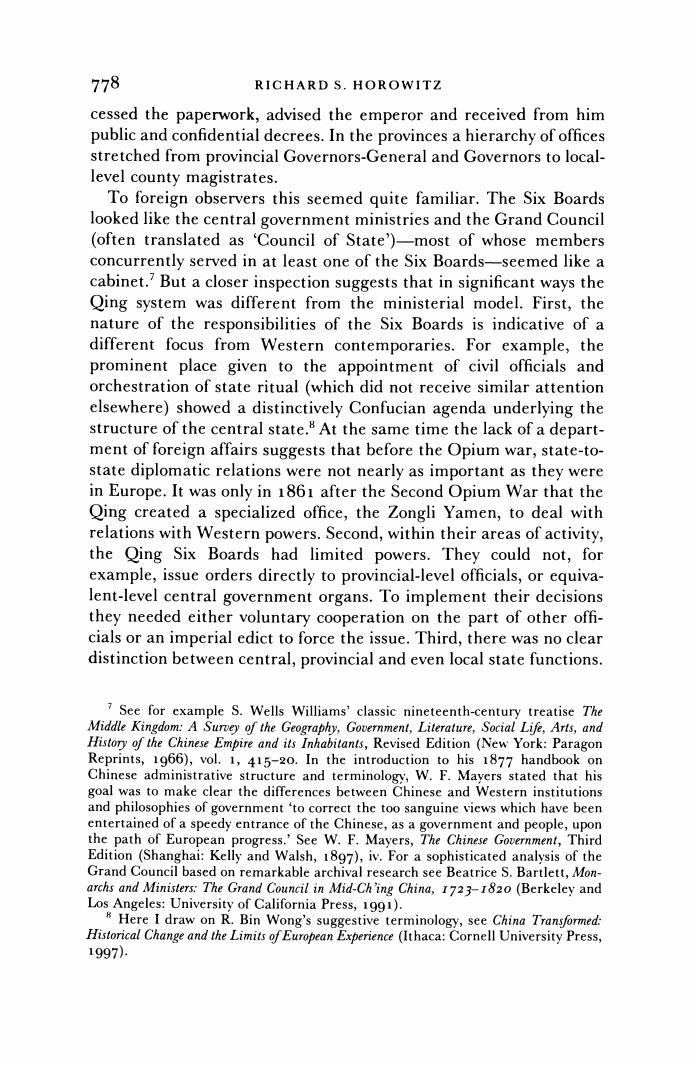正在加载图片...

778 RICHARD S.HOROWITZ cessed the paperwork,advised the emperor and received from him public and confidential decrees.In the provinces a hierarchy of offices stretched from provincial Governors-General and Governors to local- level county magistrates. To foreign observers this seemed quite familiar.The Six Boards looked like the central government ministries and the Grand Council (often translated as 'Council of State')-most of whose members concurrently served in at least one of the Six Boards-seemed like a cabinet.?But a closer inspection suggests that in significant ways the Qing system was different from the ministerial model.First,the nature of the responsibilities of the Six Boards is indicative of a different focus from Western contemporaries.For example,the prominent place given to the appointment of civil officials and orchestration of state ritual (which did not receive similar attention elsewhere)showed a distinctively Confucian agenda underlying the structure of the central state.3 At the same time the lack of a depart- ment of foreign affairs suggests that before the Opium war,state-to- state diplomatic relations were not nearly as important as they were in Europe.It was only in 1861 after the Second Opium War that the Qing created a specialized office,the Zongli Yamen,to deal with relations with Western powers.Second,within their areas of activity, the Qing Six Boards had limited powers.They could not,for example,issue orders directly to provincial-level officials,or equiva- lent-level central government organs.To implement their decisions they needed either voluntary cooperation on the part of other offi- cials or an imperial edict to force the issue.Third,there was no clear distinction between central,provincial and even local state functions. 7 See for example S.Wells Williams'classic nineteenth-century treatise The Middle Kingdom:A Survey of the Geography,Government,Literature,Social Life,Arts,and History of the Chinese Empire and its Inhabitants,Revised Edition (New York:Paragon Reprints,1966),vol.1,415-20.In the introduction to his 1877 handbook on Chinese administrative structure and terminology,W.F.Mayers stated that his goal was to make clear the differences between Chinese and Western institutions and philosophies of government 'to correct the too sanguine views which have been entertained of a speedy entrance of the Chinese,as a government and people,upon the path of European progress.'See W.F.Mayers,The Chinese Government,Third Edition (Shanghai:Kelly and Walsh,1897),iv.For a sophisticated analysis of the Grand Council based on remarkable archival research see Beatrice S.Bartlett,Mon- archs and Ministers:The Grand Council in Mid-Ch'ing China,1723-1820 (Berkeley and Los Angeles:University of California Press,1991). #Here I draw on R.Bin Wong's suggestive terminology,see China Transformed: Historical Change and the Limits of European Experience (Ithaca:Cornell University Press, 1997).778 RICHARD S. HOROWITZ cessed the paperwork, advised the emperor and received from him public and confidential decrees. In the provinces a hierarchy of offices stretched from provincial Governors-General and Governors to locallevel county magistrates. To foreign observers this seemed quite familiar. The Six Boards looked like the central government ministries and the Grand Council (often translated as 'Council of State')-most of whose members concurrently served in at least one of the Six Boards-seemed like a cabinet.' But a closer inspection suggests that in significant ways the Qing system was different from the ministerial model. First, the nature of the responsibilities of the Six Boards is indicative of a different focus from Western contemporaries. For example, the prominent place given to the appointment of civil officials and orchestration of state ritual (which did not receive similar attention elsewhere) showed a distinctively Confucian agenda underlying the structure of the central state.8 At the same time the lack of a department of foreign affairs suggests that before the Opium war, state-tostate diplomatic relations were not nearly as important as they were in Europe. It was only in 1861 after the Second Opium War that the Qing created a specialized office, the Zongli Yamen, to deal with relations with Western powers. Second, within their areas of activity, the Qing Six Boards had limited powers. They could not, for example, issue orders directly to provincial-level officials, or equivalent-level central government organs. To implement their decisions they needed either voluntary cooperation on the part of other officials or an imperial edict to force the issue. Third, there was no clear distinction between central, provincial and even local state functions. 7 See for example S. Wells Williams' classic nineteenth-century treatise The Middle Kingdom: A Survey of the Geography, Government, Literature, Social Life, Arts, and History of the Chinese Empire and its Inhabitants, Revised Edition (New York: Paragon Reprints, 1966), vol. 1, 415-20. In the introduction to his 1877 handbook on Chinese administrative structure and terminology, W. F. Mayers stated that his goal was to make clear the differences between Chinese and Western institutions and philosophies of government 'to correct the too sanguine views which have been entertained of a speedy entrance of the Chinese, as a government and people, upon the path of European progress.' See W. F. Mayers, The Chinese Government, Third Edition (Shanghai: Kelly and Walsh, 1897), iv. For a sophisticated analysis of the Grand Council based on remarkable archival research see Beatrice S. Bartlett, Monarchs and Ministers: The Grand Council in Mid-Ch'ing China, I723-1820 (Berkeley and Los Angeles: University of California Press, 1991). 8 Here I draw on R. Bin Wong's suggestive terminology, see China Transformed: Historical Change and the Limits ofEuropean Experience (Ithaca: Cornell University Press, 1997)